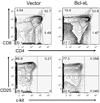Critical roles of the PI3K/Akt signaling pathway in T cell development
- PMID: 18243340
- PMCID: PMC2322870
- DOI: 10.1016/j.imlet.2007.12.008
Critical roles of the PI3K/Akt signaling pathway in T cell development
Abstract
Thymocyte development requires an integration of extracellular cues to enforce lineage commitment at multiple defined checkpoints in a stage-specific manner. Critical signals from the pre-TCR, Notch, and the receptor for interleukin-7 (IL-7) dictate cellular differentiation from the CD4(-)CD8(-) (double negative) stage to the CD4+CD8+ (double positive) stage. The PI3K/Akt signaling pathway is required to translate these extracellular signaling events into multiple functional outcomes including cellular survival, proliferation, differentiation, and allelic exclusion at the beta-selection checkpoint. However, a complete understanding of the contributions made by the PI3K/Akt pathway in thymocyte development has not been straightforward. This review highlights studies that support the model that the PI3K/Akt pathway is essential for thymocyte survival. We provide new evidence that Akt-mediated survival is not solely due to the increased expression of Bcl-xL but also is a consequence of the role played by Akt to support metabolism in proliferating thymocytes.
Figures

Similar articles
-
CD28 costimulation mediates down-regulation of p27kip1 and cell cycle progression by activation of the PI3K/PKB signaling pathway in primary human T cells.J Immunol. 2002 Mar 15;168(6):2729-36. doi: 10.4049/jimmunol.168.6.2729. J Immunol. 2002. PMID: 11884439
-
Akt1 and Akt2 are required for alphabeta thymocyte survival and differentiation.Proc Natl Acad Sci U S A. 2007 Jul 17;104(29):12105-10. doi: 10.1073/pnas.0705285104. Epub 2007 Jul 3. Proc Natl Acad Sci U S A. 2007. PMID: 17609365 Free PMC article.
-
Attenuation of the phosphatidylinositol 3-kinase/Akt signaling pathway by Porphyromonas gingivalis gingipains RgpA, RgpB, and Kgp.J Biol Chem. 2015 Feb 20;290(8):5190-5202. doi: 10.1074/jbc.M114.591610. Epub 2015 Jan 6. J Biol Chem. 2015. PMID: 25564612 Free PMC article.
-
The phosphatidylinositol 3-kinase/AKT/mammalian target of rapamycin signaling network and the control of normal myelopoiesis.Histol Histopathol. 2010 May;25(5):669-80. doi: 10.14670/HH-25.669. Histol Histopathol. 2010. PMID: 20238304 Review.
-
Regulation and importance of the PI3K/Akt/mTOR signaling pathway in hematologic malignancies.Anticancer Agents Med Chem. 2009 Nov;9(9):1024-38. doi: 10.2174/187152009789377772. Anticancer Agents Med Chem. 2009. PMID: 19663778 Review.
Cited by
-
Phospho-Specific Flow Cytometry Reveals Signaling Heterogeneity in T-Cell Acute Lymphoblastic Leukemia Cell Lines.Cells. 2022 Jun 29;11(13):2072. doi: 10.3390/cells11132072. Cells. 2022. PMID: 35805156 Free PMC article.
-
A kinase-dead knock-in mutation in mTOR leads to early embryonic lethality and is dispensable for the immune system in heterozygous mice.BMC Immunol. 2009 May 20;10:28. doi: 10.1186/1471-2172-10-28. BMC Immunol. 2009. PMID: 19457267 Free PMC article.
-
Targeting PDK1 with dichloroacetophenone to inhibit acute myeloid leukemia (AML) cell growth.Oncotarget. 2016 Jan 12;7(2):1395-407. doi: 10.18632/oncotarget.6366. Oncotarget. 2016. PMID: 26593251 Free PMC article.
-
Signaling by the phosphoinositide 3-kinase family in immune cells.Annu Rev Immunol. 2013;31:675-704. doi: 10.1146/annurev-immunol-032712-095946. Epub 2013 Jan 16. Annu Rev Immunol. 2013. PMID: 23330955 Free PMC article. Review.
-
Selected extracellular microRNA as potential biomarkers of multiple sclerosis activity--preliminary study.J Mol Neurosci. 2015 May;56(1):154-63. doi: 10.1007/s12031-014-0476-3. Epub 2014 Dec 10. J Mol Neurosci. 2015. PMID: 25487315 Free PMC article.
References
-
- Aifantis I, Mandal M, Sawai K, Ferrando A, Vilimas T. Regulation of T-cell progenitor survival and cell-cycle entry by the pre-T-cell receptor. Immunol Rev. 2006;209:159–169. - PubMed
-
- Bhandoola A, von Boehmer H, Petrie HT, Zuniga-Pflucker JC. Commitment and developmental potential of extrathymic and intrathymic T cell precursors: plenty to choose from. Immunity. 2007;26:678–689. - PubMed
-
- Godfrey DI, Kennedy J, Suda T, Zlotnik A. A developmental pathway involving four phenotypically and functionally distinct subsets of CD3−CD4−CD8− triple-negative adult mouse thymocytes defined by CD44 and CD25 expression. J Immunol. 1993;150:4244–4252. - PubMed
Publication types
MeSH terms
Substances
Grants and funding
LinkOut - more resources
Full Text Sources
Research Materials

